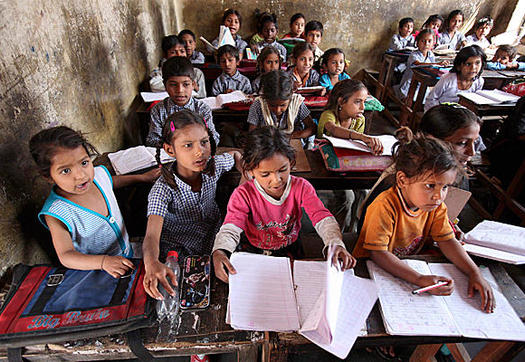According to the United Nations, 10 percent of the world’s population lives on less than $1.90 a day. Globally five percent of people (368 million) are living in extreme poverty and the majority belong to India, Nigeria, Congo, Ethiopia and Bangladesh. Globally 13 percent of people do not have access to electricity and 40 percent do not have access to clean fuels for cooking.
Approximately 22000 children die each day due to living in poverty. It is a fact that at this time there are 2.2 billion children in this world and one billion of them live in poverty. In the last decade, global poverty has decreased by half but it is a reality that 71 percent of the world population is still living in low-income or poor conditions (less than $10 per day income).
If the government helps poor children to get a good education (either technical/skill-based or higher education) then in the future they would be able to get good jobs or develop entrepreneurial setups. It will boost their income, they will not remain poor and such families would come out of the cycle of poverty. So free of cost & purposeful education for poor children, the creation of jobs and financing of small entrepreneurial setups are effective ways to break the poverty cycle in Pakistan. Government must formulate and implement policies for the above said three paradigms because it is a way toward a prosperous and sustainable future.
The trend of a gradual decrease in poverty in the last decade was interrupted in 2020 when poverty rose due to the disruption caused by the covid-19 crisis combined with the effects of conflict and climate change. Surprisingly, the wealth of the top 100 people in this world is enough to eliminate extreme poverty in this world.
It is very important to understand the cycle of poverty before statring to think about poverty reduction. It is simple to understand. If there is a poor family then due to poverty their children will grow up in poverty and such poor children have little or no access to education and skills. As a result, in the future, they would be unable to find suitable work. Their income will be low then again they become a poor family and this cycle of poverty will remain to continue.
According to HIES surveys, in Pakistan, the poverty rate was 61.6 percent in 1998 which has reduced to 21.5 percent by 2018. But on the other hand, it is a fact that 77.60 percent of Pakistan’s population lives in poor conditions (less than $5.50 per day income).
In Pakistan, the government tried to reduce poverty by introducing different poverty alleviation programmes. In March 1967, the government introduced the Social Security Programme for employees. In 1970, Workers’ Welfare Fund Scheme and Workers’ Children Education Ordinance were initiated by the government. In 1976, the Employees Old Age Benefits Institution (EOBI) was established. The Zakat and Ushr department was established in 1980. Government set up the Pakistan Bait-ul-Mal (PBM) as an autonomous corporate body in 1992. The Pakistan Poverty Alleviation Fund (PPAF) was founded in 1997 by the government to help the poor through loans. Now, it is working with the World Bank. The Benazir Income Support Programme was launched in 2008 especially to help poor women. The Ehsaas Programme was introduced in 2019.
No doubt, the government seriously took the above measures to decrease poverty but these are not enough to achieve the goal. It needs innovative and deep thinking to rapidly reduce poverty. No doubt, inequality is the main cause of poverty. The biggest inequality that needs to be addressed is gender inequality. So, women’s empowerment is the remedy to reduce poverty. Government must introduce innovative climate change solutions and must promote climate justice to develop resilience against climate change. Education is an effective tool to reduce poverty and improve the lives of people. According to UNESCO, if all students in low-income countries had just basic reading and writing skills (nothing else), an estimated 171 million people could escape extreme poverty.
Government must provide technical or skill-based education to the children of poor families or must provide scholarships to a maximum number of students. Technical or skill-based education will provide skilled labour to industry. Peace is required for economic activities and it is a basic requirement of any poverty alleviation programme. The Government must provide micro-financing schemes to issue loans to skillful people for small businesses. But to promote small businesses, efficient and easy cash transfer services are also required. Good health is required for focused working. So, the government must provide free or low-cost health facilities for poor families
In Pakistan, 60 percent of labour is dependent on agriculture. In rural areas, it is possible to reduce poverty by adopting sustainable agriculture techniques. Home gardening is an effective way to reduce kitchen expenditures and it helps to reduce poverty. Dairy and livestock development could help to improve the financial status of poor families. Government must provide ICT training to poor students and develop ease for ICT or outsourcing-related working. It is an effective way to reduce poverty as well as to bring foreign remittances to Pakistan also.
If the government helps poor children to get a good education (either technical/skill-based or higher education) then in the future they would be able to get good jobs or develop entrepreneurial setups. It will boost their income, they will not remain poor and such families would come out of the cycle of poverty. So free of cost & purposeful education for poor children, the creation of jobs and financing of small entrepreneurial setups are effective ways to break the poverty cycle in Pakistan. Government must formulate and implement policies for the above said three paradigms because it is a way toward a prosperous and sustainable future.























